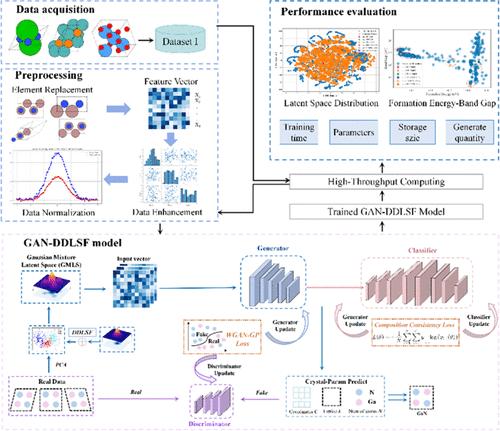当前位置:
X-MOL 学术
›
J. Chem. Theory Comput.
›
论文详情
Our official English website, www.x-mol.net, welcomes your
feedback! (Note: you will need to create a separate account there.)
Crystal Structure Prediction Using Generative Adversarial Network with Data-Driven Latent Space Fusion Strategy
Journal of Chemical Theory and Computation ( IF 5.7 ) Pub Date : 2024-10-25 , DOI: 10.1021/acs.jctc.4c01096 Zian Chen, Haichao Li, Chen Zhang, Hongbin Zhang, Yongxiao Zhao, Jian Cao, Tao He, Lina Xu, Hongping Xiao, Yi Li, Hezhu Shao, Xiaoyu Yang, Xiao He, Guoyong Fang
Journal of Chemical Theory and Computation ( IF 5.7 ) Pub Date : 2024-10-25 , DOI: 10.1021/acs.jctc.4c01096 Zian Chen, Haichao Li, Chen Zhang, Hongbin Zhang, Yongxiao Zhao, Jian Cao, Tao He, Lina Xu, Hongping Xiao, Yi Li, Hezhu Shao, Xiaoyu Yang, Xiao He, Guoyong Fang

|
Crystal structure prediction (CSP) is an important field of material design. Herein, we propose a novel generative adversarial network model, guided by a data-driven approach and incorporating the real physical structure of crystals, to address the complexity of high-dimensional data and improve prediction accuracy in materials science. The model, termed GAN-DDLSF, introduces a novel sampling method called data-driven latent space fusion (DDLSF), which aims to optimize the latent space of generative adversarial networks (GANs) by combining the statistical properties of real data with a standard Gaussian distribution, effectively mitigating the “mode collapse” problem prevalent in GANs. Our approach introduces a more refined generation mechanism specifically for binary crystal structures such as gallium nitride (GaN). By optimizing for the specific crystallographic features of GaN while maintaining structural rationality, we achieve higher precision and efficiency in predicting and designing structures for this particular material system. The model generates 9321 GaN binary crystal structures, with 16.59% reaching a stable state and 24.21% found to be metastable. These results can significantly enhance the accuracy of crystal structure predictions and provide valuable insights into the potential of the GAN-DDLSF approach for the discovery and design of binary, ternary, and multinary materials, offering new perspectives and methods for materials science research and applications.
中文翻译:

使用具有数据驱动潜在空间融合策略的生成对抗网络进行晶体结构预测
晶体结构预测 (CSP) 是材料设计的一个重要领域。在此,我们提出了一种新的生成对抗网络模型,以数据驱动的方法为指导,并结合晶体的真实物理结构,以解决高维数据的复杂性并提高材料科学的预测准确性。该模型称为 GAN-DDLSF,引入了一种称为数据驱动潜在空间融合 (DDLSF) 的新型采样方法,旨在通过将真实数据的统计特性与标准高斯分布相结合来优化生成对抗网络 (GAN) 的潜在空间,有效缓解 GAN 中普遍存在的“模式崩溃”问题。我们的方法引入了一种更精细的生成机制,专门用于二元晶体结构,例如氮化镓 (GaN)。通过优化 GaN 的特定晶体学特征,同时保持结构合理性,我们在预测和设计这种特定材料系统的结构时实现了更高的精度和效率。该模型生成了 9321 个 GaN 二元晶体结构,其中 16.59% 达到稳定状态,24.21% 达到亚稳态。这些结果可以显著提高晶体结构预测的准确性,并为 GAN-DDLSF 方法在二元、三元和多元材料发现和设计方面的潜力提供有价值的见解,为材料科学研究和应用提供新的视角和方法。
更新日期:2024-10-25
中文翻译:

使用具有数据驱动潜在空间融合策略的生成对抗网络进行晶体结构预测
晶体结构预测 (CSP) 是材料设计的一个重要领域。在此,我们提出了一种新的生成对抗网络模型,以数据驱动的方法为指导,并结合晶体的真实物理结构,以解决高维数据的复杂性并提高材料科学的预测准确性。该模型称为 GAN-DDLSF,引入了一种称为数据驱动潜在空间融合 (DDLSF) 的新型采样方法,旨在通过将真实数据的统计特性与标准高斯分布相结合来优化生成对抗网络 (GAN) 的潜在空间,有效缓解 GAN 中普遍存在的“模式崩溃”问题。我们的方法引入了一种更精细的生成机制,专门用于二元晶体结构,例如氮化镓 (GaN)。通过优化 GaN 的特定晶体学特征,同时保持结构合理性,我们在预测和设计这种特定材料系统的结构时实现了更高的精度和效率。该模型生成了 9321 个 GaN 二元晶体结构,其中 16.59% 达到稳定状态,24.21% 达到亚稳态。这些结果可以显著提高晶体结构预测的准确性,并为 GAN-DDLSF 方法在二元、三元和多元材料发现和设计方面的潜力提供有价值的见解,为材料科学研究和应用提供新的视角和方法。


















































 京公网安备 11010802027423号
京公网安备 11010802027423号